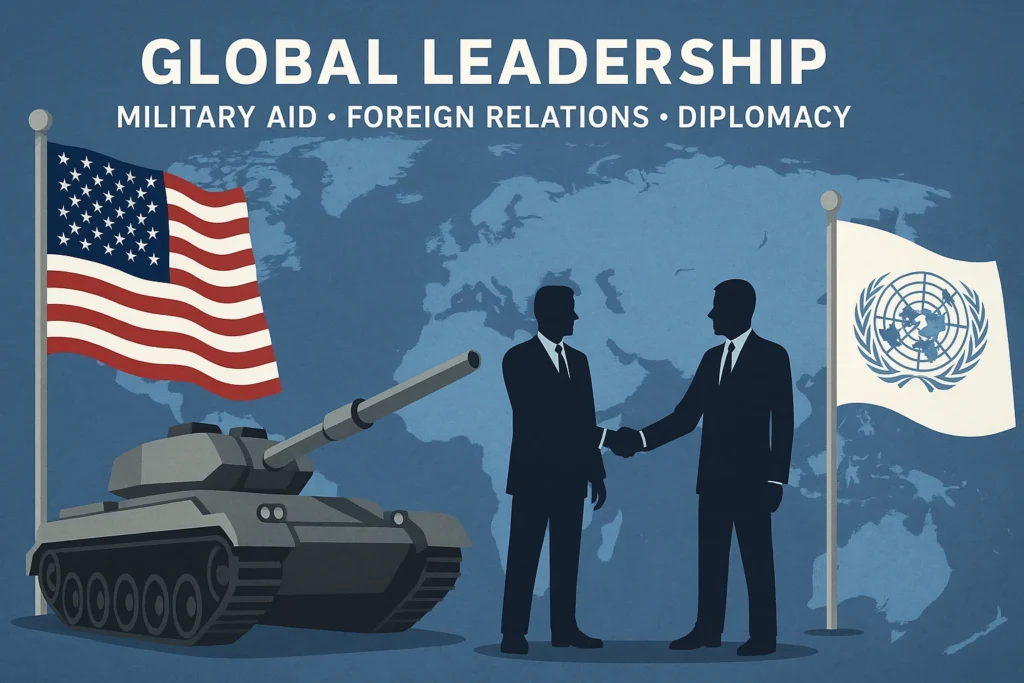Introduction: A Big Player in a Connected World
Have you ever wondered how a country like the United States, far away from many global hotspots, ends up so involved in conflicts and peace efforts around the world? It’s a bit like being a really good team captain in a huge, interconnected game. When big problems pop up – whether it’s a war, a natural disaster, or a disagreement between nations – many eyes turn to America. Why? Because the U.S. is a major global leader, with a powerful military, a strong economy, and a history of working with other countries.
But what does that actually look like? It means the U.S. is constantly engaging with global tensions, offering help when needed, and keeping promises to its allies. Let’s take a closer look at how America plays its part in today’s complicated world.
The Weight of Global Tensions: Ukraine, Russia, Taiwan, and China
The world is a busy place, and unfortunately, disagreements and conflicts are a part of it. Two of the biggest challenges the U.S. is currently grappling with involve Ukraine and Russia, and Taiwan and China.
The Ukraine-Russia War: A Test of Resolve
Imagine your neighbor attacking another neighbor. That’s essentially what happened when Russia launched a full-scale invasion of Ukraine. This wasn’t just a local dispute; it sent shockwaves across the globe. For the United States, it became a crucial moment to show its commitment to international rules and to standing up for countries under attack.
How has the U.S. engaged? It’s a multi-pronged approach. First, there’s the massive amount of military aid. Since Russia’s full-scale invasion in February 2022, the U.S. has provided Ukraine with over $66.5 billion in military assistance. This isn’t just cash; it’s a huge variety of equipment, including advanced weapons like HIMARS rocket systems, Javelin anti-tank missiles, artillery rounds, armored vehicles (like MRAPs and HMMWVs), and even sophisticated drones and air defense systems. This aid is vital for Ukraine to defend its territory and its people. Think of it as providing protective gear and crucial supplies to someone who’s bravely fighting for their home.
Beyond military support, the U.S. has also led efforts to impose economic sanctions on Russia. These are like financial penalties aimed at hurting Russia’s economy to pressure it to stop the war. The U.S. has targeted Russian banks, key individuals in Putin’s inner circle, and important sectors of the Russian economy, including energy and defense industries. The goal is to limit Russia’s ability to fund its war machine. The U.S. has also worked closely with its allies in Europe and beyond to coordinate these efforts and provide humanitarian aid to the millions of Ukrainians displaced by the conflict, offering food, shelter, and medical assistance.
The Taiwan-China Dynamic: A Delicate Balance
On the other side of the world, a different kind of tension is brewing between China and Taiwan. China views Taiwan as a part of its own territory and has made it clear it intends to eventually unify with the island, by force if necessary. Taiwan, however, sees itself as a self-governing democracy with its own elected government.
The U.S. has a long-standing, but carefully balanced, relationship with both. While the U.S. officially acknowledges Beijing’s “One China” policy (meaning it recognizes only one China), it also maintains strong unofficial ties with Taiwan. This relationship is governed by the Taiwan Relations Act of 1979, which commits the U.S. to providing Taiwan with defensive weapons so it can protect itself if China were to launch an attack. For example, the U.S. has been one of Taiwan’s top arms buyers for decades.
This policy is often called “strategic ambiguity” – it doesn’t explicitly state whether the U.S. would intervene militarily in a conflict, but it keeps China guessing and acts as a deterrent. The U.S.’s chief goal is to maintain peace and stability in the Taiwan Strait and encourage both Beijing and Taipei to resolve their differences peacefully. Washington states it does not support Taiwanese independence but opposes any unilateral changes to the status quo by either side. The U.S. is walking a tightrope here, trying to deter aggression while also avoiding actions that could provoke a direct conflict with China, which is a major global power itself. Diplomacy, quiet conversations, and clear communication are key to managing this delicate situation.
The Power of Helping Hands: Foreign Aid Around the Globe
It’s not all about conflicts. A big part of America’s role in the world involves helping other countries, especially those in need. This is where foreign aid comes in. It’s like a neighbor offering a helping hand when someone is struggling, whether it’s with poverty, a natural disaster, or a health crisis. Many Americans might overestimate how much the U.S. spends on foreign aid; it typically makes up about 1% of the U.S. federal budget.
U.S. foreign aid comes in many forms. It can be:
- Humanitarian aid: This is immediate assistance provided after emergencies. For example, after an earthquake in Turkey or Syria, the U.S. quickly provided food, water, medical supplies, and search-and-rescue teams. The U.S. is often the largest donor to organizations like the World Food Programme, providing crucial support in areas facing famine or displacement.
- Development aid: This is about investing in long-term projects that help countries grow and become more stable. This includes funding for building schools, improving healthcare systems, developing sustainable agriculture, and supporting democratic institutions. A notable example is the President’s Emergency Plan for AIDS Relief (PEPFAR), which since its launch in 2003, has provided care to millions and trained hundreds of thousands of health workers, especially in sub-Saharan Africa, dramatically increasing access to life-saving HIV/AIDS treatment.
- Security aid: This type of aid helps countries strengthen their own security forces to combat terrorism, fight drug trafficking, or maintain regional peace. This can involve training, equipment, and logistical support.
Why does the U.S. do this? Part of it is simply about being a good global citizen and helping those in need. But there’s also a strategic side. When countries are stable and prosperous, they are less likely to become hotbeds for extremism, conflict, or uncontrolled migration, which ultimately benefits everyone, including the United States. Investing in other nations’ well-being can contribute to global peace and security, which is in America’s own interest.
Standing Together: The Importance of NATO Commitments
Imagine a group of friends who have promised to look out for each other. That’s a bit like the North Atlantic Treaty Organization, or NATO. It’s a military alliance formed after World War II, primarily to deter aggression from the Soviet Union (now Russia). Today, it’s a group of 32 countries, mostly in North America and Europe, who have a simple but powerful agreement: an attack on one member is considered an attack on all (Article 5 of the NATO treaty).
The U.S. is a founding member and a key player in NATO. Its commitment to this alliance is a cornerstone of its foreign relations, representing a shared defense against common threats. When Russia invaded Ukraine, NATO became even more vital. While Ukraine is not a NATO member, the alliance has significantly strengthened its defenses in Eastern Europe, deploying more troops, equipment, and conducting exercises, sending a clear message to Russia that any aggression against a NATO country would be met with a unified and powerful response.
The U.S. contributes significantly to NATO’s common funding. For example, in 2024, the U.S. contributed about 16% of NATO’s common budget, roughly $753 million, which is a tiny fraction of its total military spending. More importantly, U.S. military personnel are stationed in various NATO countries – for instance, over 34,000 in Germany and over 12,000 in Italy – participating in joint training exercises and contributing to the collective defense. This isn’t just about showing military strength; it’s about building trust, coordinating strategies, and ensuring that allies are prepared to act together if the need arises. America’s commitment to NATO is a powerful symbol of its dedication to collective security and its allies, fostering stability across the Euro-Atlantic region.
Global Leadership: What Does It Really Mean?
We often hear the term “global leadership” when talking about the U.S. But what does that truly mean in practice? It’s more than just being the most powerful country. It involves:
- Diplomacy: This is the art of conducting negotiations and building relationships between nations. The U.S. engages in countless conversations, meetings, and agreements with other countries and international organizations like the United Nations to resolve disputes peacefully and build consensus on global issues. Think of it as talking things out rather than fighting, using skilled negotiators to find common ground.
- Setting Norms and Rules: The U.S. often works with international organizations and other countries to establish shared rules for how nations should behave on the world stage. This includes agreements on trade, human rights, arms control, and environmental protection. These rules create a more predictable and stable international system.
- Convening Power: This refers to the U.S.’s ability to bring different countries together to address common challenges. Whether it’s a summit on climate change, a meeting to coordinate responses to a pandemic, or discussions on global economic stability, the U.S. often plays a central role in gathering nations and driving collective action.
- Providing Resources: Beyond money, this includes contributing significant financial, military aid, and humanitarian resources to global efforts. This can be in the form of intelligence sharing, logistical support for international missions, or scientific expertise to tackle global problems.
Being a global leader isn’t always easy. It means making tough decisions, sometimes facing criticism, and constantly adapting to new challenges. But for the U.S., it’s a role it has embraced, believing that a stable and peaceful world ultimately benefits its own security and prosperity.
The Shifting Sands of Foreign Relations
The world is constantly changing, and so are America’s foreign relations. New friendships are forged, old alliances are strengthened, and sometimes, relationships become more complicated.
One of the biggest shifts we’re seeing is the rise of new global powers, particularly China. This means the U.S. is not the only major player on the block, and it often has to find ways to cooperate and compete with other powerful nations simultaneously. The U.S. is engaged in strategic competition with China across various fronts, including technology, defense, and economic influence.
Another aspect of evolving foreign relations is the increasing importance of cybersecurity. As the world becomes more connected digitally, threats like cyberattacks from hostile countries or groups become a major concern. The U.S. is working with allies to develop strategies to protect critical infrastructure, share intelligence on these threats, and deter malicious cyber activities that could destabilize economies or even provoke conflicts.
Climate change is also a growing area of focus in foreign relations. The U.S. is engaging with other countries to find global solutions to reduce greenhouse gas emissions and adapt to the changing climate, recognizing that no single country can tackle this challenge alone. This often involves international agreements and sharing of green technologies.
Furthermore, the rise of populism and nationalism in various parts of the world also presents challenges to traditional diplomacy. These movements can lead to countries focusing more inward, sometimes making international cooperation more difficult. The U.S. navigates these shifts by continuously adapting its diplomatic strategies and strengthening alliances with like-minded democracies.
The Debate at Home: Weighing the Costs and Benefits
While America’s role in global affairs is extensive, it’s also a topic of ongoing debate within the country. People often ask important questions and hold different viewpoints:
- Is it too expensive? Foreign aid, military spending, and diplomatic efforts all cost money, and some argue these resources could be better spent at home on domestic issues like healthcare, education, or infrastructure.
- Are we getting too involved? Others worry about the U.S. getting bogged down in conflicts far from its borders, reminiscent of prolonged engagements like the war in Afghanistan. They might argue that intervening in other nations’ affairs can lead to unintended consequences or resentment.
- Is it truly making a difference? There’s a constant discussion about the effectiveness of U.S. foreign policy and whether its actions are leading to the desired outcomes, such as promoting democracy or ensuring stability. Some critics point to past interventions that didn’t achieve their goals or even worsened situations.
- Shouldn’t other countries do more? There’s often a feeling that the U.S. carries too much of the burden of global security and assistance, and that other wealthy nations should contribute more. This is a common point of discussion, particularly regarding NATO members’ defense spending.
These are valid questions, and they reflect the complexities of being a global power in a democracy. There’s no easy answer, and different administrations and political leaders often have different approaches to these issues. However, what remains consistent for many is the recognition that the U.S. cannot simply isolate itself from the rest of the world. What happens in distant lands can quickly impact America, whether it’s through economic ripple effects, the spread of diseases, the rise of new threats like terrorism or cyberattacks, or the disruption of global supply chains. Many argue that active engagement, while costly and challenging, is ultimately necessary for U.S. security and prosperity in an interconnected world.
Conclusion: A Continuous Journey on the Global Stage
America’s role in global conflicts and diplomacy is a continuous journey, filled with responsibilities and complex choices. It’s about navigating difficult challenges, offering support to those in need, and standing firm with allies. From providing vital military aid and humanitarian assistance to Ukraine as it defends against Russian aggression, to carefully balancing relations in the tense Taiwan Strait, and from investing in long-term development projects in impoverished nations to strengthening international alliances like NATO, the U.S. remains a central figure on the world stage.
This role requires careful decisions, constant engagement, and a willingness to adapt to new global realities. Understanding how the U.S. interacts with the world helps us all appreciate the intricate web of global relations and the ongoing, often challenging, effort to build a more peaceful and stable future for everyone.



